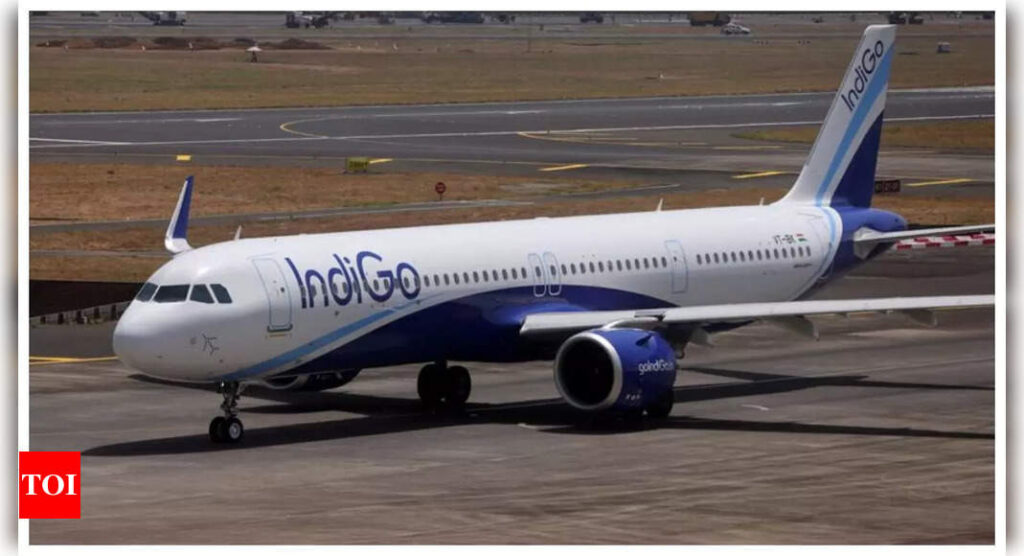[ad_1]
NEW DELHI: IndiGo, India’s largest airline, is considering the introduction of a premium seating class, hot meals, and a loyalty program by the end of 2024. According to a report in the Economic Times, IndiGo‘s move is part of its strategy to attract more business travelers and compete with Air Indiaon international routes, according to sources familiar with the matter.The airline plans to modify 35 Airbus A321 aircraft with a dual-class configuration, including a premium cabin featuring eight rows of seats, arranged two on each side.
“Eight rows with extra legroom seating will be installed in those aircraft, providing 36 inches of legroom for guests to stretch out or work comfortably,” a source, who preferred anonymity, told the ET. Currently, IndiGo’s Airbus A320 and A321 aircraft offer an average seat pitch of 30 inches. The airline has not yet finalized the additional charges for these premium seats, but customers opting for them can expect benefits like priority boarding, complimentary in-flight food, and more flexibility in itinerary changes. An IndiGo spokesperson declined to comment on these plans.
IndiGo’s existing no-frills model, which involves dense cabin seating and additional charges for food, priority boarding, and seat allocation, has been successful domestically, helping it secure a 60% market share. However, under the leadership of CEO Pieter Elbers, who joined from Air France-KLM in 2021, and director Greg Sarestky, the airline is now aiming to expand its dominance to international routes. This includes the introduction of longer flights with Airbus A321 XLR aircraft from 2025, targeting European markets with flight times exceeding seven hours. These planes will also feature business class seats and more legroom in economy class, the ET report said.
Elbers had previously mentioned the consideration of dual-class seating but confirmed no final decision. “The speed of market development is so fast and we have kept all options open. A lot of startups, new companies are being founded in India and they will all go international. All that needs travel and at one point needs a different class of travel,” he said.
A source aware of the strategy told the ET that a premium section would help IndiGo attract high-yield customers currently choosing rivals like Air India and Vistara. The airline aims to offer a business class product at lower fares than legacy airlines, leveraging its lower unit cost advantage. Investors are cautiously observing this shift, hoping it won’t compromise IndiGo’s successful low-cost model. Aviation consultancy firm CAPA cautioned against overestimating premium traffic, which could lead to strategic errors in transitioning from a low-cost to a hybrid airline model.
“Eight rows with extra legroom seating will be installed in those aircraft, providing 36 inches of legroom for guests to stretch out or work comfortably,” a source, who preferred anonymity, told the ET. Currently, IndiGo’s Airbus A320 and A321 aircraft offer an average seat pitch of 30 inches. The airline has not yet finalized the additional charges for these premium seats, but customers opting for them can expect benefits like priority boarding, complimentary in-flight food, and more flexibility in itinerary changes. An IndiGo spokesperson declined to comment on these plans.
IndiGo’s existing no-frills model, which involves dense cabin seating and additional charges for food, priority boarding, and seat allocation, has been successful domestically, helping it secure a 60% market share. However, under the leadership of CEO Pieter Elbers, who joined from Air France-KLM in 2021, and director Greg Sarestky, the airline is now aiming to expand its dominance to international routes. This includes the introduction of longer flights with Airbus A321 XLR aircraft from 2025, targeting European markets with flight times exceeding seven hours. These planes will also feature business class seats and more legroom in economy class, the ET report said.
Elbers had previously mentioned the consideration of dual-class seating but confirmed no final decision. “The speed of market development is so fast and we have kept all options open. A lot of startups, new companies are being founded in India and they will all go international. All that needs travel and at one point needs a different class of travel,” he said.
A source aware of the strategy told the ET that a premium section would help IndiGo attract high-yield customers currently choosing rivals like Air India and Vistara. The airline aims to offer a business class product at lower fares than legacy airlines, leveraging its lower unit cost advantage. Investors are cautiously observing this shift, hoping it won’t compromise IndiGo’s successful low-cost model. Aviation consultancy firm CAPA cautioned against overestimating premium traffic, which could lead to strategic errors in transitioning from a low-cost to a hybrid airline model.
[ad_2]
Source link











More Stories
India’S Growth Forecast: S&P ups India’s FY’24 growth forecast to 6.4% on robust domestic momentum
India to remain fastest-growing major economy, but demand uneven: Poll
Jack Ma: Jack Ma gets back into business with ‘Ma’s Kitchen Food’